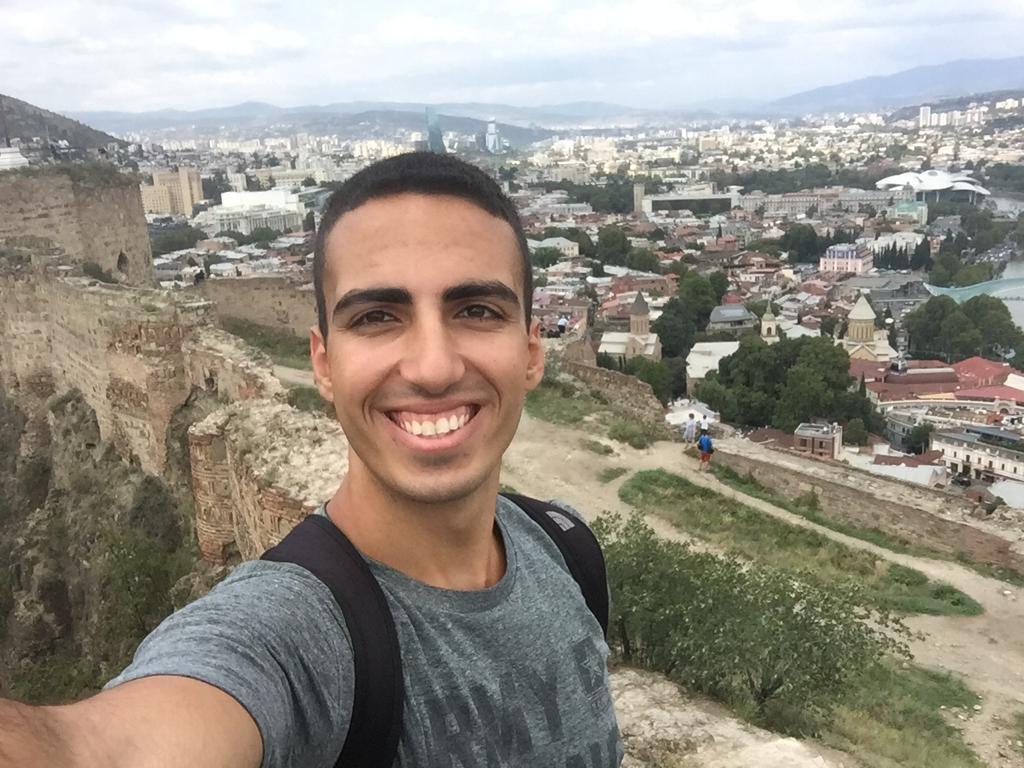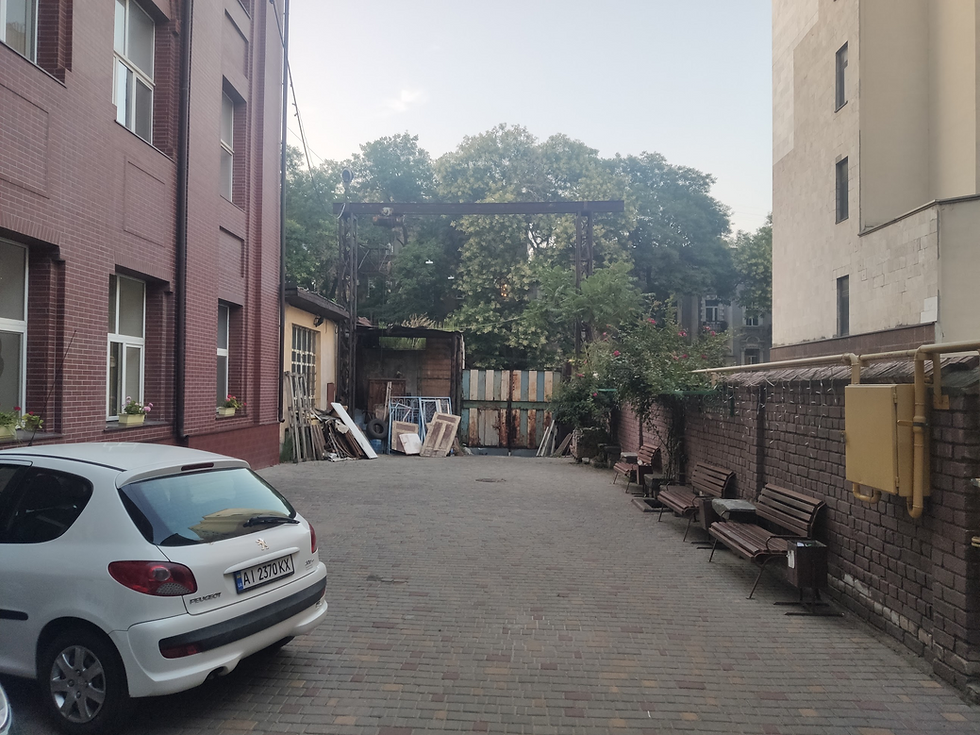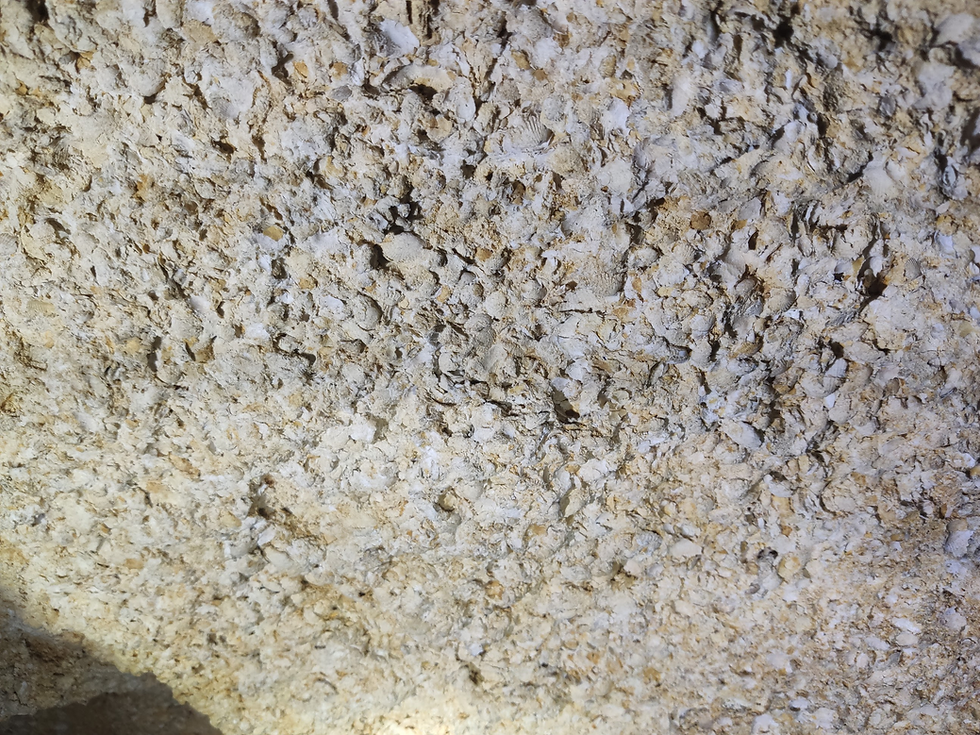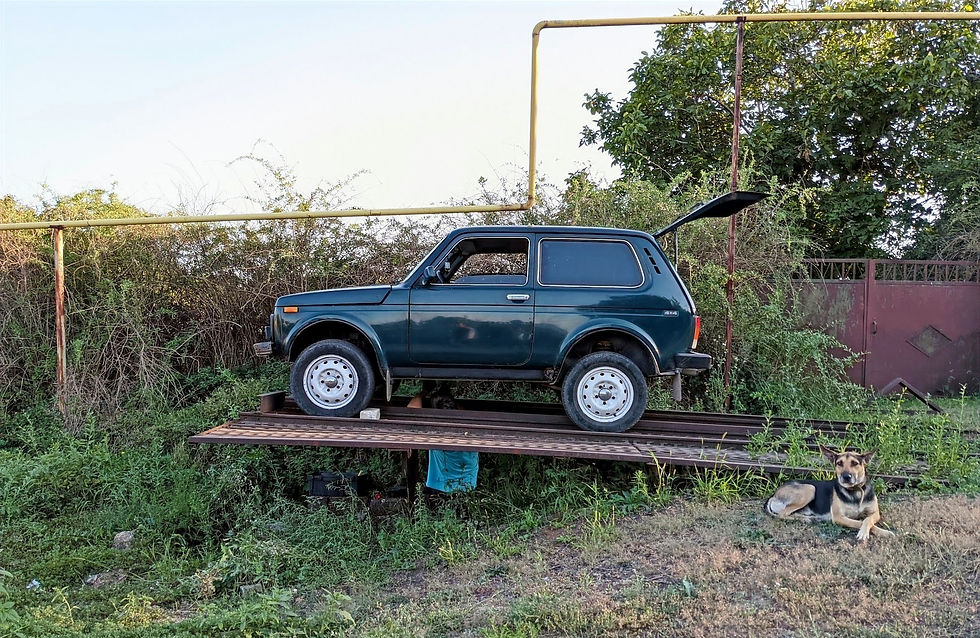Odessa, Ukrainian Sin City
- Aaron Schorr

- Aug 22, 2021
- 12 min read
I've decided that my old posts were too long, so from here out I will be attempting to publish a separate post for each city to keep the length down.
We arrived at the Ukrainian border post and faced a soldier at passport control. I handed him all the relevant documents - passport, vaccination card, and proof of Ukrainian COVID insurance, which we had purchased with great difficulty over lunch in Tiraspol - and he immediately went for the phone to ask his superior if Israelis could enter without a problem. Bilal had had a hell of a time at the Odessa airport earlier, so I sure hoped the answer was yes. Sure enough, I got a Ukrainian entry stamp in my passport. Since we had transited through Transnistria, there would be no record of us exiting Moldova, so I asked him if we could get a штамп на выход из Молдовы (stamp for exiting Moldova). He picked up the phone again and summoned a Moldovan border police official, who took our passports and stamped us out of the country for the unlikely case that I would ever return on my Israeli passport. Thus, despite the border being de facto between Transnistria and Ukraine, the border crossing was functionally trilateral, an impressive degree of collaboration in an occupied territory.

The Home Stretch
The road after the border post had several kiosks and зеленые карты (green cards for automotive insurance), but no money changers. All we had for local currency was now-worthless Transnistrian rubles, so unless we could get some Ukrainian hryvnia (UAH), we would have to pay for our ride to town with a $20 bill and I wasn’t expecting change. Fortunately, the small crowd waiting for the marshrutka to Odessa directed us several hundred meters further down the road, where there was a small money changing office by the roadside.
The marshrutka wouldn’t leave before it was full, so people were milling about, smoking, or napping shirtless in the sweltering vehicle until it departed. Instead of taking us to the city center, however, the van dropped us in the village of Avangard on its outskirts, where the driver told me to cross the road and take bus number 201 to the city. We crossed the busy intersection with a strange concrete monument at its center to Одесса Город Героем (Odessa, City of Heroes), clearly a Soviet relic since it was in Russian and not Ukrainian. The bus was another Soviet relic, shuddering violently every time it started moving or screamed to a halt using the loudest brakes I’ve ever heard. It was the worst ride I could remember since the bus that took us to Russkiy Island from Vladivostok, and it took us on a spectacular detour through the southern outskirts of the city, but it was dirt-cheap at 7 UAH (¢26). It was a very unattractive area, featureless concrete khrushchevkas with some colorful houses mixed in among lots and lots of uneven train tracks that made the bus shudder even more.


We got off at the train station and walked the several minutes to our hotel through streets that were at least more attractive, and reunited with Bilal. It was good that we did, because we never would have found our room on our own - we had to walk out of the reception into an courtyard with industrial equipment and a pizza place, walk through a nondescript door, climb a flight of stairs, and find the correct room. The place had weird cat-themed decor and shared squat toilets, which were the norm from here to the Pacific Ocean. Fortunately, our trips to Georgia and Russia had taugh us this particular skill.
We regrouped after our tiring journey through Moldova and Transnistria and headed out for dinner. The elderly receptionist was on the toilet in her office with the door open when we left, but headed out to give us very detailed instructions in Ukrainian on how to return, of which we did not understand a word - we either absolutely had to knock on the window to wake her, or absolutely not knock on the window to wake her. We had a delicious dinner at a Georgian restaurant and swapped stories about the 48 hours we had spent apart.
Yiddish Culture and Fermented Bread
In keeping with our tradition, we booked a free walking tour for the morning and set out to meet our guide. After 10 minutes of walking, we realized we were heading in the exact opposite direction across downtown Odessa's grid. We dashed across town towards the Vorontsov Monument, the Russian nobleman and field marshal whose wife had an affair with Pushkin in the 1830s, producing what are considered some of the finest poems in the Russian language. The architecture rapidly improved as we moved north, and we finally caught up to our guide. There was only one other guest on the tour, a German woman named Andrea, which made it rather more awkward, and the guide had a tendency to tell stories that didn’t quite have a point. Even so, it was a good introduction to the historical part of the city, which exhibited clear Russian and Ottoman influences in its appearance.

The true architectural pearl of the city was the opera house, a magnificent neo-baroque structure built in 1887 after the previous one burnt down which looks like it belongs in Vienna or Budapest. Through a combination of luck, sabotage, and the incompetence of the city’s Romanian and German occupiers, the building survived the war entirely intact. Across the street from the opera house is a park bench with a small bronze statue which looks like an antisemitic caricature and turned out to actually be a Jewish banker from the late 19th century named Ozias Hais. Odessa has a long and rich Jewish history, and it is estimated that over half the city’s population was at least part-Jewish before the war. Yiddish terms like “oy vey” and “shikse” have become part of the local vernacular, Jewish folk tales are part of the Odessa lore, and the city’s restaurants proudly serve traditiona; Ashkenazi fare.

We continued to the city council building, which had a bell ringing on the hour that sounded like a bad MIDI organ melody and a statue of Pushkin, who spent just over a year living in Odessa. Further north are the Potemkin Stairs, made famous by the 1925 silent film Battleship Potemkin (which I confess to not have watched). The stairs are flanked by two parks, one honoring Greece and the other Istanbul, one of Odessa’s sister cities, in a very unlikely combination. For some absurd reason, the latter even has trash cans emblazoned with the logo of Istanbul’s city government, which allowed me to view one of me favorite Turkish terms again - büyükşehir belediyesi, or metropolitan government.


Past the Greek park is the Mothers-in-Law Bridge - the origin of the name is unknown, but the bridge is so flimsy that it noticeably shudders when groups of people jump on it (and we did), and the lovers’ locks on its railings had to be removed to prevent it from collapsing. The bridge crosses a rather steep ravine, and the road at the bottom had two crude figures drawn in chalk in its surface, apparently mocking people who committed suicide from the bridge. Our guide told us that something along the lines of “it isn’t high; come jump!” used to also be written on the pavement - Odessa clearly has a unique sense of humor.

The tour took us down very pretty streets on which every apartment building had apparently been occupied by a different Eastern European aristocratic dynasty before the Communist revolution. The tour ended, and Andrea joined us to get lunch at a traditional Ukrainian restaurant in town. They took tradition very seriously here, the decor aggressively trying to look like a banquet hall in a Ukrainian village and the wait staff all dressed in elaborate traditional costumes with huge flower crowns on the women’s heads. The food was on point, as well: I had black bread with schmaltz, pike varenyky (fried dumplings) with a cheese sauce, and a glass of kvass, which probably I should have tried in Moldova. Kvass is an Eastern European drink made by fermenting bread, typically with a very low alcohol content (“Slavic kombucha,” according to Bilal). It tested like really sweet and fruity non-alcoholic beer, and not in a good way, but the rest of the food was good.
"Bad Kvass is Better than Good Water" - Russian Proverb
In the Footsteps of Partisans, Satanists, and Neo-Nazis
Odessa had catacombs we wanted to visit, so we hopped aboard another creaky yellow bus to the train station. I was standing behind the driver, so I could see the battery light flash alarmingly and the speedometer fluctuate wildly between 0-40 km/h, but at least the brakes didn’t scream like hell every time we slowed down. We assumed that the location on Google Maps was the entrance to the catacombs, even if it was bicycle parking in front of the McDonalds opposite the station, but couldn’t find it anywhere we looked. None of us had data, but we managed to connect to a café’s WiFi network and discover that this was merely the meeting point for the catacomb tours which took place outside town. We scrambled to text the guide recommended online, only to find out it was the same guy running the free walking tour who agreed to send us a guide for later.
By now, my companions both needed more caffeine, so we hopped in an ancient and crowded elektrichka (electric tram) to Café Compote. This was literally the busiest spot in town, three floors of young people that could have been in any very white city. The Academic Theater of Musical Comedy across the street was hosting Odessa’s international film festival, and many of the patrons were wearing festiveval lanyards and very much looked the type. The compote, which came in four flavors, was good, too.

We met our guide, Vanya, back at the McDonalds bike lot, and boarded a bus to a village north-west of the city. Improbably, he was from Transnistria, and raised an eyebrow when we said we had been there the previous day. Vanya spent his free time exploring the Odessa catacombs, which at around 3,000 km in length were the largest such system in the world. The labyrinth of tunnels was initially dug by Russian miners to extract coquina, the sedimentary rock used to build nearly every one of Odessa’s beautiful buildings, and used until the 1930s. The rock was formed by compression of shells and mollusks at the bottom of the once-larger Black Sea, which were clearly visible throughout the tunnels.
It was only 6:00 pm, but I fell asleep in the bus and woke up to a drunk man yelling to himself and views of fields and warehouses. We got off at the entrance to a small village and walked through its streets to a nondescript cave almost hidden by its surroundings. Vanya gave us all flashlights, and we could feel the cold air blowing out of the ground - 14˚ C year-round.

The tunnels were incredible, and the wall art even more so. At different points, we encountered portraits of 19th-century miners, rebellious Baptist poems, insults directed at various explorers, a statement of support for the countries fighting against the Ottoman Empire in WWI, and a memorable manifesto in support of gay Ukrainians, which apparently was a prank by an explorer. These took their rivalry awfully seriously, to the point of laying traps for each other throughout the tunnels. There were also bones of small animals and miners’ personal belongings scattered throughout, as well as pipes dug by local villagers to use the catacombs for drainage. This carried its own problems, and Vanya showed us an impressive wall built out of coquina blocks by explorers to hold back a “lake of shit”.
The catacombs have more history than just mining. After Odessa fell to German and Romanian forces in 1941, units of NKVD partisans began using them as a hideout from which to stage sabotage and assassination missions in the area. The invaders killed thousands of civilians in retribution and sealed off whichever tunnel exits they could find, trapping some of the partisans in to die of starvation or internal conflicts. This part of the story was told with the flashlights off, leaving us in utter - and I mean utter - darkness. Opening or closing your eyes made absolutely no difference, to the point that your eyes strain against their eyelids. With the lights back on, Vanya took us to a carefully-concealed entrance in a wall which led to a room of sorts with a stone table, chairs, and candles placed in a goat’s skull. The place was designed to replicate a Satanist temple which had existed there previously, in turn replacing a neo-Nazi hideout from the 90s which was visible via an SS graffiti marking on the wall. It was a thoroughly creepy place that I won’t forget.

We retraced some of our steps in the thoroughly disorienting maze towards the exit. Vanya smiled and said we could find the exit on our own, if we were up for the challenge. We racked our brains for little visiual cues about the path we had taken, and despite a few wrong turns, managed to make it to the warm exit, where we took a celebratory photo. We walked back through the village which was now full of barbecue smoke, past a man and his son working on their Lada Niva, and Gypsy children who greeted us with “salam aleikum”. The ancient yellow bus felt normal by now, and we feasted on sandwiches we made with ingredients from a nearby supermarket. Judging by the assortment at every supermarket, Ukrainians really love their bread, but it all seems to be perpetually stale, even when warmed on the kettle in our room.
Too Much Pigment for Ibiza
Odessa is famous for its nightlife, which attracts unsavory types from the entire region. I’m really not a clubbing person, but it was one of the city’s main attraction. We got dressed and took a taxi down to Arkadia Beach, Odessa’s nightlife district. Arkadia is built as a narrow pedestrian strip, with a mall at the top and the beach at the bottom. The cab dropped us off at the top, which was perhaps a but tacky but not awful. There were lots of fair-style boardwalk activities and restaurants, including Ravarkadia, a kosher restaurant with Hebrew writing on it which was a very interesting sign of what was to come. The further down you go, the louder, more obnoxious, and less family-friendly your surroundings become, such that midway to the beach we passed a place called Prosecco which had literal children dancing in it with a strip club not 15 feet away. And yet even at the beach itself, between the bars and the clubs, there were more fairground attractions and a man offering stargazing with a telescope.

The beach has two main clubs - Ibiza and Ithaca, since Arkadia is too tacky to name places after it - connected by a series of shot bars playing deafening Russian hip-hop. All three of us were stone-cold sober - I was on a no-alcohol diet, Bilal was a good Muslim, and Yotam wanted to avoid the calories - which alone made us stick out, but Yotam ordered a “Thai Tea”, which must have had six different shots in it, and a glass of vyshnia from the same place we had been to in Moldova. We passed a latex-dressed woman dancing in a cage on a mostly empty street and I suddenly felt incredibly sad, trying to figure out how human society had failed in this direction. I wasn’t going to head back, though, so we headed to Ibiza, which was the place to be according to the Israelis we had met in Chisinau. The whole area seemed a little quiet at 11:30, but the club had free entry until midnight. We stood in line and were flat-out rejected by the Ukrainian bouncers. I tried talking to them, but they barely agreed to acknowledge my existence. We sat outside for a while, and noticed that anyone who wasn’t strictly white was turned away under a policy they called “face control”, while literally any white person who met the very lax dress code was let in. To prove this, Yotam went in alone and was immediately welcome, while slowly a crowd of non-white rejects formed around the entry.
I had never felt more humiliated in my life, and the fact that this was happening in the country with one of the worst historical records of anti-Semitism only made it worse. I took some time to calm my nerves before heading back, while Yotam went in alone and Bilal came with me. He later looked the place up and found that it had a very detailed record of racism on the internet. I still had no data, so I connected to a WiFi network named "StripClub" to order a taxi while a booming voice welcomed his "friend from Dnipro" in Russian inside the establishment and loud male cheers could be heard. Arkadia was truly an awful place.

We slept in and retuned to the northern end of town for breakfast. One of the elegant building built to house aristocratic families caught my eye. There were some neon signs in the windows, and as I approached I noticed that they were advertising a strip club as if it were in Las Vegas. Truly, Odessa could not be a trashier place if it tried. We sat at Gogol-Mogol, named after a traditionally Jewish drink made of frothed egg whites and sugar, and famous for its remedial qualities. Bilal ordered one, and it tasted exactly like an uncooked meringue (which it was), and I can’t say I recommend it. The place served traditional Ukrainian food, but it insisted on putting syrups and ice cream in all of its cold coffee drinks, which earned it the wrath of my two companions. We got some local SIM cards, shockingly without having to show any form of identification, and headed to the train station. I got a text from Jake, congratulating me on completing the Odessa Challenge: visiting both Odessa, Ukraine, and Odessa, TX, in one year. My next goal: St. Petersburg, Russia, and St. Petersburg, FL.












































Comments